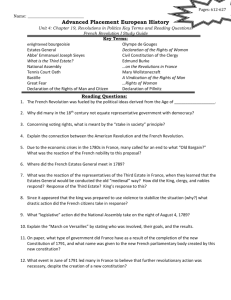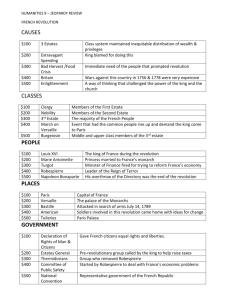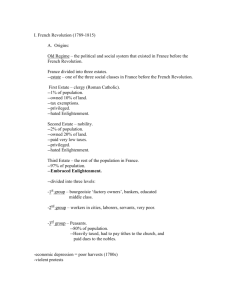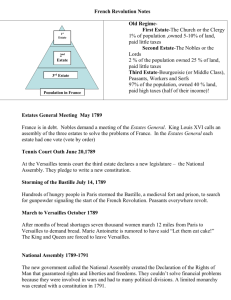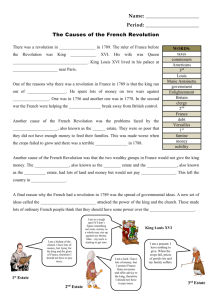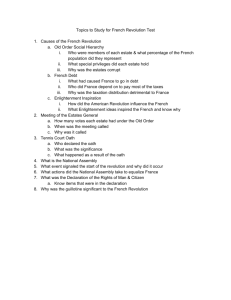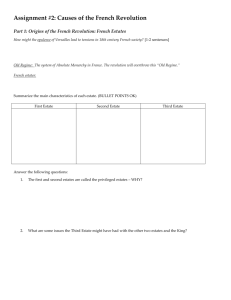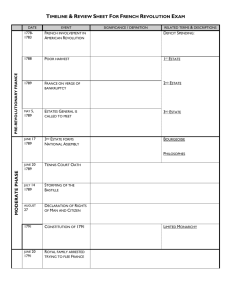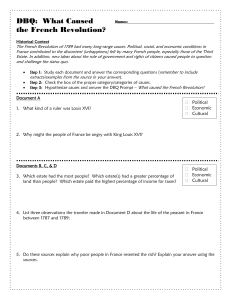Review Sheet - Guilford Public Schools
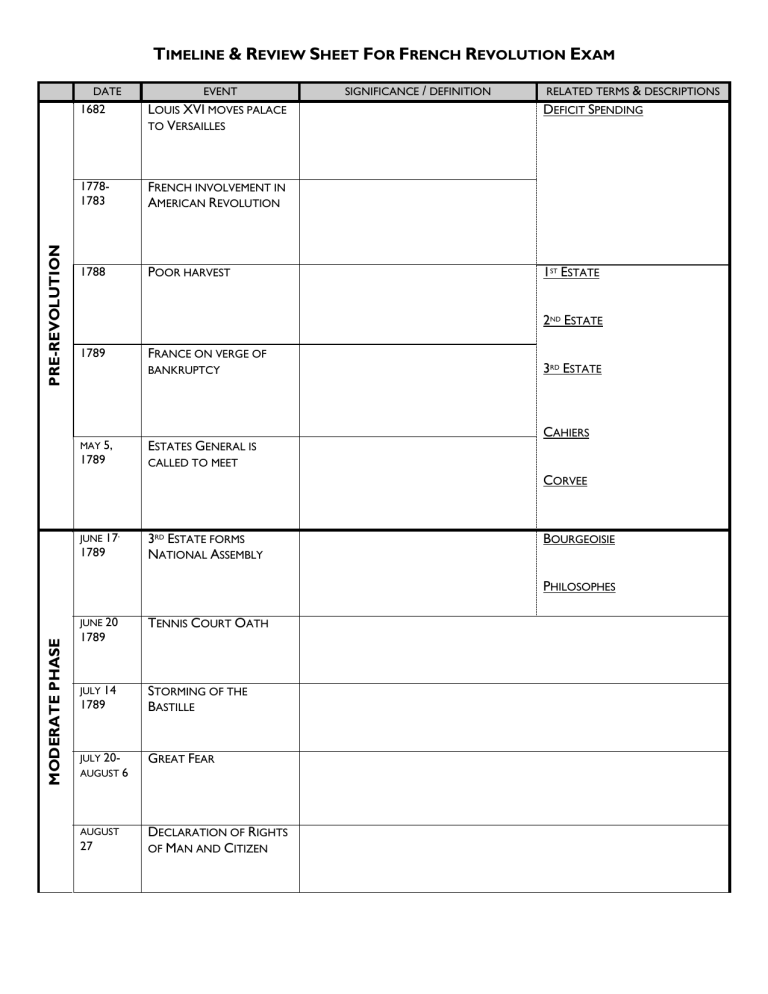
DATE
1682
T
IMELINE
& R
EVIEW
S
HEET
F
OR
F
RENCH
R
EVOLUTION
E
XAM
EVENT
L
OUIS
XVI
MOVES PALACE
TO
V
ERSAILLES
SIGNIFICANCE
/
DEFINITION RELATED TERMS
&
DESCRIPTIONS
D
EFICIT
S
PENDING
1778-
1783
F
RENCH INVOLVEMENT IN
A
MERICAN
R
EVOLUTION
1788 P
OOR HARVEST
1789 F
RANCE ON VERGE OF
BANKRUPTCY
MAY 5,
1789
E
STATES
G
ENERAL IS
CALLED TO MEET
1
ST
E
STATE
2
ND
E
STATE
3
RD
E
STATE
C
AHIERS
C
ORVEE
B
OURGEOISIE
P
HILOSOPHES
JUNE 17 ,
1789
3
RD
E
STATE FORMS
N
ATIONAL
A
SSEMBLY
JUNE 20
1789
T
ENNIS
C
OURT
O
ATH
JULY 14
1789
S
TORMING OF THE
B
ASTILLE
JULY 20-
AUGUST 6
G
REAT
F
EAR
AUGUST
27
D
ECLARATION OF
R
IGHTS
OF
M
AN AND
C
ITIZEN
OCTOBER
5
W
OMEN
’
S
M
ARCH
1790
1791
C
IVIL
C
ONSTITUTION OF
THE
C
LERGY
C
ONSTITUTION OF
1791
JUNE 20
1791
R
OYAL FAMILY ARRESTED
TRYING TO FLEE
F
RANCE
AUGUST
27 1791
D
ECLARATION OF
P
ILLNITZ
APRIL
1792-
1815
SEPTEMBER
1792
F
RANCE AT WAR WITH
A
USTRIA
, P
RUSSIA
, R
USSIA
,
B
RITAIN
&
OTHERS
N
ATIONAL
C
ONVENTION
SEPTEMBER
2-7 1792
S
EPTEMBER
M
ASSACRES
JANUARY
1793
L
OUIS
XVI & M
ARIE
A
NTOINETTE EXECUTED
APRIL 1793 C
OMMITTEE OF
P
UBLIC
S
AFETY FORMED
SEPTEMBER
1793JULY
1794
R
EIGN OF
T
ERROR
JULY 1794 R
OBESPIERRE EXECUTED
1795 C
ONSTITUTION OF
1795
1799 N
APOLEON TAKES
CONTROL OF
F
RENCH
GOVERNMENT
J
L
IMITED
M
ONARCHY
S
R
ACOBINS
ANS
C
ULOTTES
EPUBLIC
R
EPUBLIC
O
F
V
IRTUE
G
UILOTINE
D
IRECTORY
The origins of the French Revolution lay in a financial crisis brought about by wars (France was at war for twenty years between 1740 and 1783), especially by French involvement in the American War of Independence (1778-83), which greatly increased the national debt. Frivolous spending by monarchs in the construction of the
Palace of Versailles as well as _DEFICIT SPENDING__, brought on by excessive expenditures and a refusal to appropriately tax the 1 st and 2 nd Estates. The 1 st and
2 nd Estates (the clergy and nobility) resisted attempts to be taxed and demanded the calling of a representative assembly, the Estates-General. This assembly had not been called for over a century because French kings did not want to be challenged by the nobility. As 1788 came to close, France tottered on the verge of bankruptcy. Bread riots were spreading, and nobles, fearful of taxes, were denouncing royal tyranny. Louis XVI finally summoned the group to meet at Versailles the following year. In preparation, each of the three estates was supposed to prepare cahiers, lists of formal greivances. When it became clear in September 1788 that the 1 st and 2 nd Estate (which made up a 2% of the population) would be able to outvote the Third Estate (which made up 98% of the population) in the Estates-
General, the bourgeois (wealthy individuals, who lacked the social status of the nobility) leaders of the Third Estate began a struggle against the system of French government. They sought equality and this involved destroying the privileges of the Church and the nobility and the setting up of a system where promotion to high office should be based on merit, not birth, where all paid taxes on the same basis and where the law was the same for all. The poorer members of the Third Estate, wished an end to the corvee or expectation that commoners could be forced to engage in unpayed labor for the state. These Enlightened ideas were inspired by the
American Revolution as well as the writings of philosophes, who promoted the ideas of equality. The French Revolution was, above all else, a struggle for equal rights.
Fed up with the injustice of the Estates General, the Third Estate formed the National Assembly, which claimed to legitimately represent the French population. In response, the National Assembly was locked out fo the meeting of the Estates General. After being locked out, the group moved their meeting to a nearby tennis court and in the Tennis Court Oath, swore draft and pass and new constitution. In its struggle against King Louis XVI and the privileged orders — for the two had combined to resist the bourgeois assault — the National Assembly needed the support of the Paris populace. In July 1789 the Crown prepared to use force to dissolve the Estates-General and National Assembly. It was prevented from doing so by the rising of the sans-culottes, the poorly dressed artisans and workers of Paris who, in the first great movement of the Revolution, attacked the Bastille on 14 July, 1789. This saved the Assembly and ensured the success of the Revolution, as the King lost control of Paris and of the towns. The King lost control of the countryside too in a peasant revolution, which spread over most of France during the Great Fear (20
July-6 August 1789). During late August 1789. The National Assembly issued The Declaration of the Rights of Man. This document, which was heavily influenced by the American Declaration of Independence, asserted that all “men were born free and equal in rights.” The King initially refused to accept the declaration. However, as bread prices rose and people starved, Women’s March on Versailles forced Louis XVI and the rest of the royal family to return to Paris. For many members of the Third Estate, king’s wife, Marie Antoinette was the symbol of the frivolous and extravagant nature of the monarchy. Early in the revolution, the radical press spread a fictional story that she had answered the peasants cries for bread by saying, “let them eat cake” if there is no bread to be had. Once back in Paris, LouisXVI was forced to sign the Declaration of Rights of Man in 1791.
The National Assembly also worked to solve the financial crisis that France faced. To pay of the government’s debt they voted to take over and sell Church lands.
Issued in 1790, the Civil Constitution of the Clergy declared that bishops and priests would become salaried, elected officials and that papal authority was ended in
France. Many Catholics in and out of France were angered by this decree and began to support the counter-revolution. During the following year, the National
Assembly completed the task of the Tennis Court Oath and declared the Consitution of 1791, which established a constitutional monarchy in France. In the new government, all of the king’s executive power would be subject to a legislative assembly for approval. Fearful for both the lives of the monarchy and the possibility of revolution spreading throughout Europe, Austria and Prussia issued the Declaration of Pilnitz which threatened military action to support the French monarchy. This eventually led to the French declaring war on Austria, Prussia and Britain. These wars began in 1792 and lasted on and off until 1815.
In September of 1792, the National Convention replaced the Legislative Assembly and abolished the monarchy, declaring France a republic. In the same month, the
Prussian invasion of France caused panic in the capital, and prisoners who had been accused of being supporters of the monarch were hastily tried and executed by mobs. These events were referred to as the September Massacres. The King and Queen were tried and executed in January 1793. As the wars caused widespread panic, inflation and bread shortages, people feared that the revolution would not survive. This led to support for the Jacobins, the most radical wing of the National
Convention. As the Jacobins gained power in the government, they became increasingly concerned with those who did not fully support the revolution. Led by
Robespierre, the Committee of Public Safety was formed to swiftly deal with problems at home and abroad. Initially, this committee overcame the dangers facing
France by driving out the invaders and controlling food prices. However, the committee also was responsible for the Reign of Terror; a ten month period of oppression and execution aimed at suppressing any potential threats to the Revolution. Robespierre defended the Reign of Terror in his famous speech known as the “Republic of Virtue.” It is believed that close to 40,000 people were executed during this time period. Executions were the result of hasty and unjust trials and were carried out through the invention of the guillotine which quickly and effectively beheaded those that were sentenced to death. Eventually, Robespierre was executed and as the Reign of Terror ended, a new constitution was formed. This was known as the Constitution of 1795. This new constitution set of a 5-man
Directory and two-house legislature elected by any male citizen that owned property. The system of government was short lived and in 1799, Napoleon Bonaparte, a popular military hero, overthrew the Directory and became the First Consul of France.
